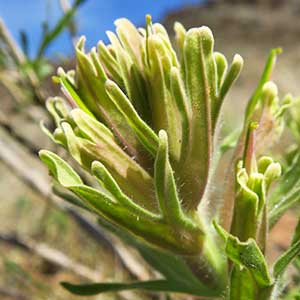Castilleja rubida
Castilleja xanthotricha
little reddish Indian paintbrush, purple alpine paintbrush, purple paintbrush, Wallowa alpine paintbrush
John Day or yellow-hairy paintbrush, John Day paintbrush, yellow hair paintbrush, yellow-hair Indian paintbrush
several, decumbent, or ascending, unbranched, hairs moderately dense, spreading, short and long, soft, eglandular and glandular.
few to several, ± decumbent to erect or ascending, unbranched, sometimes with short, leafy axillary shoots, hairs erect to spreading, long, soft, eglandular, mixed with short stipitate-glandular ones.
green to purple, linear to narrowly lanceolate, 0.7–3.2 cm, not fleshy, margins plane, slightly involute, 3–5-lobed, apex narrowly acute to acuminate;
lobes ascending-spreading, narrowly linear to filiform, often curling, often short, apex acute or obtuse.
green, linear, lanceolate to broadly lanceolate, oblong, or cuneate, 0.8–5 cm, not fleshy, margins plane to wavy, involute, 0–5-lobed, apex acute, sometimes rounded;
lobes spreading, linear, arising below mid length, nearly as broad as center lobe, apex acute.
2.5–6 × 1–2 cm;
bracts purple, deep burgundy, or lavender throughout, rarely pink or yellowish white throughout, sometimes pink or dull whitish on distal margins and apices, oblong, 3–5(–7)-lobed;
lobes spreading, linear, medium length, proximal lobes arising below mid length, center lobe apex rounded to obtuse, lateral ones acute to obtuse.
3–14 × 1.5–4.5 cm;
bracts proximally greenish, rarely dull reddish purple, distally white to cream, rarely pale yellow or dull, pale pink (sharply differentiated from proximal coloration), lanceolate or oblong to narrowly ovate, (3–)5–7-lobed;
lobes ascending, linear to obovate, ± broadened distally, medium, long, proximal lobes arising below mid length, central lobe apex broadly rounded to truncate, others acute to rounded.
straight, 12–15 mm;
tube 14–16 mm;
abaxial lip and beak exserted;
beak adaxially green, 5–6 mm;
abaxial lip colored as distal portion of bracts, prominent, pouches 3, central one grooved, pouches not strongly inflated, 4–5 mm, 80–100% as long as beak;
teeth erect, appressed to beak, colored as distal portions of bracts, 1.5–2.5 mm.
curved, 17–23 mm;
tube 15–19 mm;
beak exserted, adaxially green, 5–8(–9) mm, puberulent, stipitate-glandular;
abaxial lip deep purple (color sometimes visible through calyx), green, pinkish, or pale yellow, ± prominent, slightly inflated, usually hidden in calyx, sometimes right at top of calyx, 2 mm, ca. 50% as long as beak;
teeth ascending, whitish, yellowish, pink, or green, 1–1.5 mm.
colored as bracts, 10–12 mm; all 4 clefts subequal, 3.5–6.5 mm, 35–55% of calyx length;
lobes broadly linear or linear-triangular, apex obtuse to acute.
colored as bracts, 15–26 mm;
abaxial and adaxial clefts 3.5–7 mm, 25–50% of calyx length, deeper than laterals, lateral 2–5 mm, 12–25% of calyx length;
lobes linear, oblong, or narrowly triangular, center lobe apex usually rounded, lobes acute to rounded.
green.
= 48.
Castilleja rubida
Castilleja xanthotricha
Castilleja rubida is a rare alpine species endemic to a few limestone peaks in the Wallowa Mountains of northeastern Oregon, entirely within the Eagle Cap Wilderness Area. It is likely derived from the C. nana complex, found in the mountains of eastern California and Nevada, but it is amply distinct. Due to its very limited range and small population numbers, C. rubida is a species of conservation concern.
(Discussion copyrighted by Flora of North America; reprinted with permission.)
Castilleja xanthotricha is endemic to moderate elevations in the sagebrush hills of the John Day River drainage in north-central Oregon. N. H. Holmgren (1971) hypothesized that this tetraploid species is of allopolyploid hybrid origin between C. glandulifera and C. oresbia.
(Discussion copyrighted by Flora of North America; reprinted with permission.)


